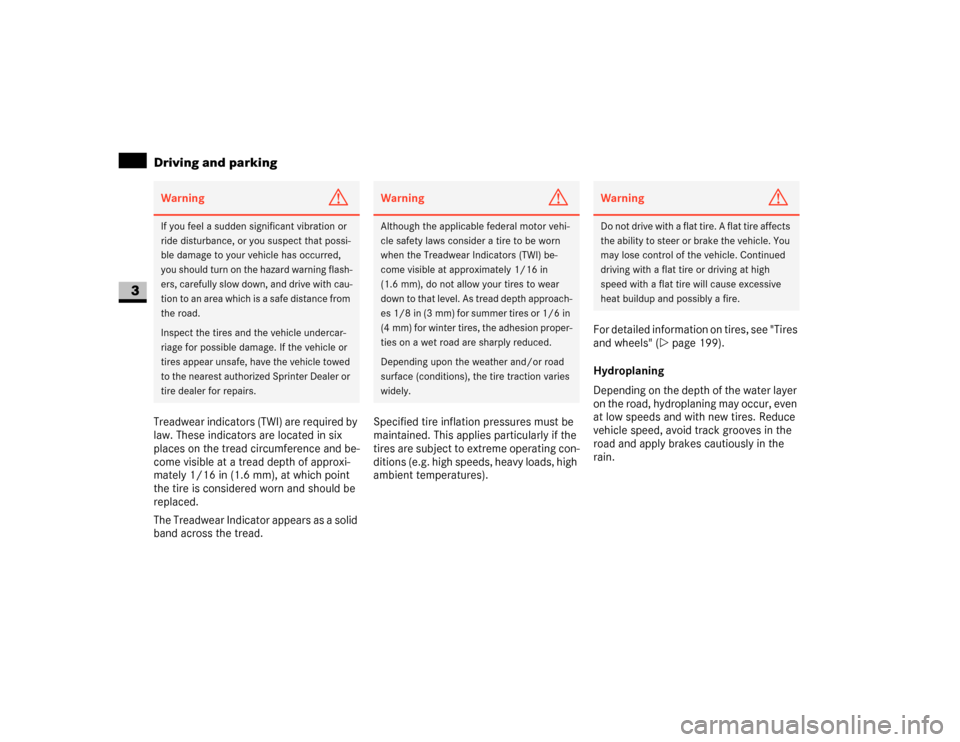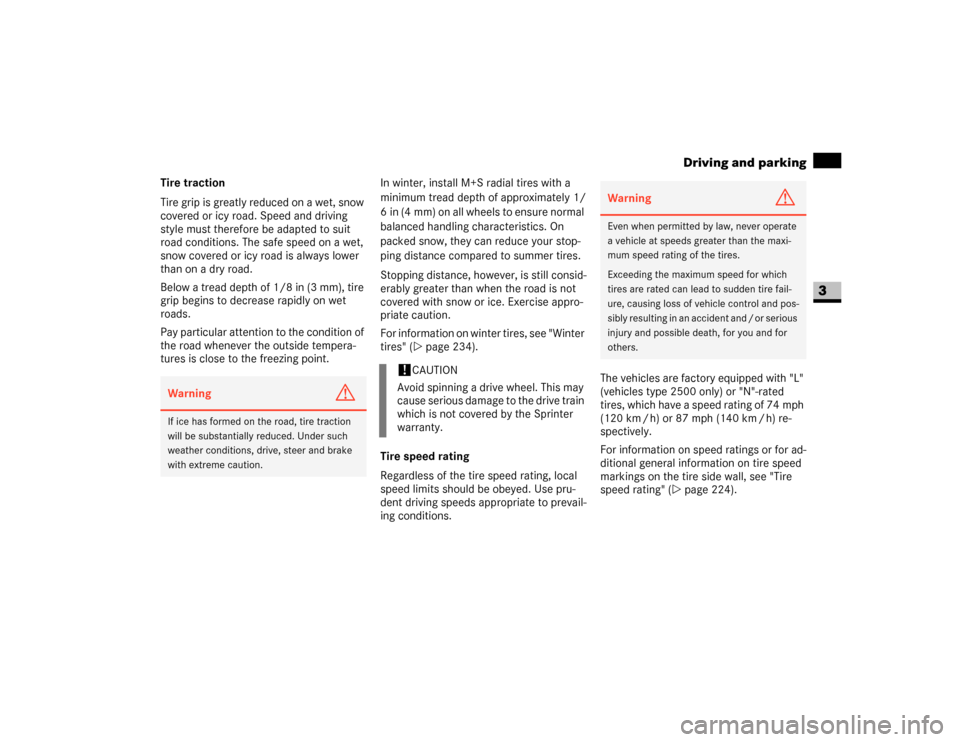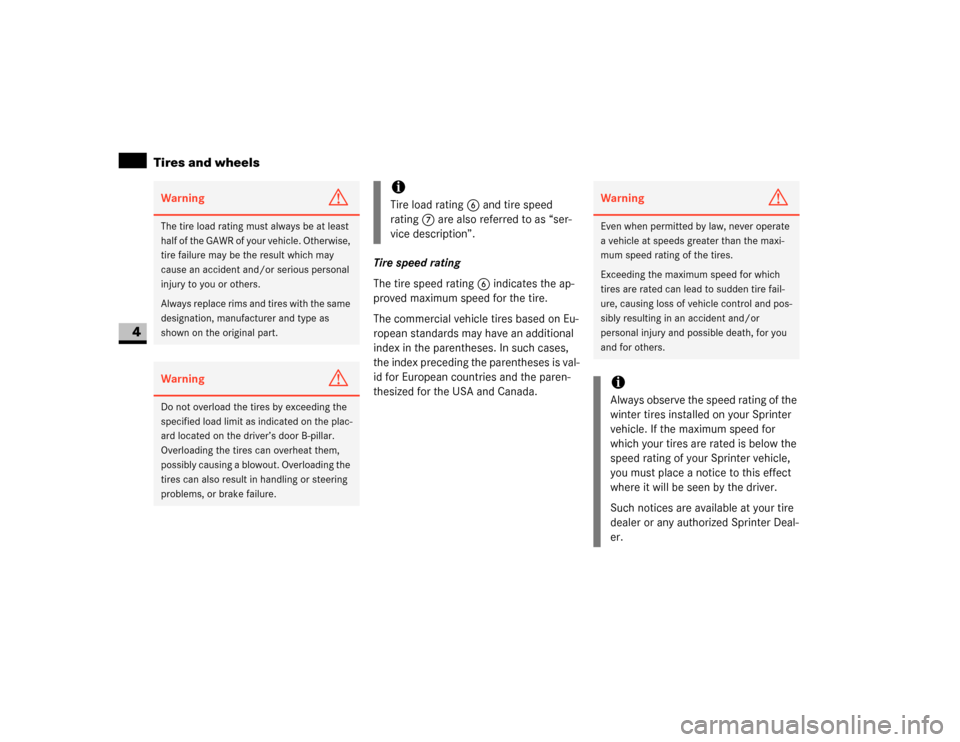2007 DODGE SPRINTER winter tires
[x] Cancel search: winter tiresPage 43 of 393

42 SafetyDriving safety systems
2
\3 Driving safety systemsIn this section, you will find information
about the following driving safety systems:
\4ABS (A
ntilock B
rake S
ystem)
\4BAS (B
rake As
sist)
\4ESP
® (E
lectronic S
tability P
rogram)
\4ASR (acceleration skid control)
\4EBV (electronic brake force distribu-
tion)ABS regulates the brake pressure in such a
way that the wheels do not lock when you
brake. This allows you to continue steering
when braking.
ABS works from a speed of about 3 mph
(5 km/h) upwards, regardless of road sur-
face conditions.
ABS works on slippery surfaces, even
when you only brake gently.
There is a malfunction if the - indicator
lamp is permanently lit while the engine is
running (\2page 271).
Despite this, the normal driving and brak-
ing functions remain available.
iThe maximum effect of ABS, BAS,
ESP
®, ASR and EBV can only be
achieved if you:
\4always drive with the correct tire
pressures adjusted according to
the load (\2page 210)
\4use winter tires (M+S tires) in win-
try conditions, with snow chains if
necessary
Warning
G
There is an increased risk of an accident if
you:
\4drive too fast, in particular when corner-
ing and on a wet or slippery road surface
\4drive too close to the vehicle in front
The driving safety systems described in this
section cannot reduce this risk and are un-
able to override the laws of physics.
Always adapt your driving style to the pre-
vailing road and weather conditions, and
maintain an adequately safe distance from
other road users as well as any obstacles on
the road.iOnly use wheels with the recommend-
ed tire sizes (\2page 367), otherwise
the driving safety systems will not work
correctly.
Antilock Brake System (ABS)Warning
G
Do not depress the brake pedal several
times in quick succession (pumping). De-
press the brake firmly and evenly. Pumping
the brake pedal may reduce the braking ef-
fect.
Page 119 of 393

118 Controls in detailDriving and parking
3
Treadwear indicators (TWI) are required by
law. These indicators are located in six
places on the tread circumference and be-
come visible at a tread depth of approxi-
mately 1/16 in (1.6 mm), at which point
the tire is considered worn and should be
replaced.
The Treadwear Indicator appears as a solid
band across the tread.Specified tire inflation pressures must be
maintained. This applies particularly if the
tires are subject to extreme operating con-
ditions (e.g. high speeds, heavy loads, high
ambient temperatures).For detailed information on tires, see "Tires
and wheels" (\2page 199).
Hydroplaning
Depending on the depth of the water layer
on the road, hydroplaning may occur, even
at low speeds and with new tires. Reduce
vehicle speed, avoid track grooves in the
road and apply brakes cautiously in the
rain.Warning
G
If you feel a sudden significant vibration or
ride disturbance, or you suspect that possi-
ble damage to your vehicle has occurred,
you should turn on the hazard warning flash-
ers, carefully slow down, and drive with cau-
tion to an area which is a safe distance from
the road.
Inspect the tires and the vehicle undercar-
riage for possible damage. If the vehicle or
tires appear unsafe, have the vehicle towed
to the nearest authorized Sprinter Dealer or
tire dealer for repairs.
Warning
G
Although the applicable federal motor vehi-
cle safety laws consider a tire to be worn
when the Treadwear Indicators (TWI) be-
come visible at approximately 1/16 in
(1.6 mm), do not allow your tires to wear
down to that level. As tread depth approach-
es 1/8 in (3 mm) for summer tires or 1/6 in
(4 mm) for winter tires, the adhesion proper-
ties on a wet road are sharply reduced.
Depending upon the weather and/or road
surface (conditions), the tire traction varies
widely.
Warning
G
Do not drive with a flat tire. A flat tire affects
the ability to steer or brake the vehicle. You
may lose control of the vehicle. Continued
driving with a flat tire or driving at high
speed with a flat tire will cause excessive
heat buildup and possibly a fire.
Page 120 of 393

119 Controls in detail
Driving and parking
3
Tire traction
Tire grip is greatly reduced on a wet, snow
covered or icy road. Speed and driving
style must therefore be adapted to suit
road conditions. The safe speed on a wet,
snow covered or icy road is always lower
than on a dry road.
Below a tread depth of 1/8 in (3 mm), tire
grip begins to decrease rapidly on wet
roads.
Pay particular attention to the condition of
the road whenever the outside tempera-
tures is close to the freezing point.In winter, install M+S radial tires with a
minimum tread depth of approximately 1/
6 in (4 mm) on all wheels to ensure normal
balanced handling characteristics. On
packed snow, they can reduce your stop-
ping distance compared to summer tires.
Stopping distance, however, is still consid-
erably greater than when the road is not
covered with snow or ice. Exercise appro-
priate caution.
For information on winter tires, see "Winter
tires" (\2page 234).
Tire speed rating
Regardless of the tire speed rating, local
speed limits should be obeyed. Use pru-
dent driving speeds appropriate to prevail-
ing conditions.The vehicles are factory equipped with "L"
(vehicles type 2500 only) or "N"-rated
tires, which have a speed rating of 74 mph
(120 km / h) or 87 mph (140 km / h) re-
spectively.
For information on speed ratings or for ad-
ditional general information on tire speed
markings on the tire side wall, see "Tire
speed rating" (\2page 224).Warning
G
If ice has formed on the road, tire traction
will be substantially reduced. Under such
weather conditions, drive, steer and brake
with extreme caution.
!
CAUTION
Avoid spinning a drive wheel. This may
cause serious damage to the drive train
which is not covered by the Sprinter
warranty.
Warning
G
Even when permitted by law, never operate
a vehicle at speeds greater than the maxi-
mum speed rating of the tires.
Exceeding the maximum speed for which
tires are rated can lead to sudden tire fail-
ure, causing loss of vehicle control and pos-
sibly resulting in an accident and / or serious
injury and possible death, for you and for
others.
Page 174 of 393

173
4 Operation
The first 1000 miles (1,500 km) ......... 174
Driving tips ......... 175
Electronic equipment ......... 183
Refueling ......... 184
Engine ......... 185
Battery ......... 195
Battery isolating switch* ......... 197
Tires and wheels ......... 199
Winter driving ......... 234
Maintenance and servicing ......... 237
Cleaning and care of the vehicle ......... 241
Page 200 of 393

199 Operation
Tires and wheels
4
\3 Tires and wheelsThe tires on a new vehicle provide a bal-
ance of many characteristics. They should
be inspected regularly for wear and correct
cold tire inflation pressure. The vehicle
manufacturer strongly recommends using
tires equivalent to the originals in size,
quality and performance when a replace-
ment becomes necessary.
Refer to the tire and loading information
placard on the driver’s door B-pillar
(\2page 373) for the size designation of
your tire.
The service description and load identifica-
tion will be found on the original equip-
ment tire. Failure to use equivalent
replacement tires may adversely affect the
safety, handling, and ride of your Sprinter
vehicle.
Contact an authorized Sprinter Dealer or
an authorized tire dealer with any ques-
tions you may have on tire specifications
or capability.For more information on tire size designa-
tion, load and speed rating, see "Tire label-
ing" (\2page 222).
See an authorized Sprinter Dealer for infor-
mation on tested and recommended rims
and tires for summer and winter operation.
They can also offer advice concerning tire
service and purchase.
!
CAUTION
Only use tires which have been tested
and approved for your Sprinter vehicle
by the vehicle manufacturer. Tires ap-
proved by the vehicle manufacturer are
developed to provide the best possible
performance in conjunction with the
driving safety systems on your Sprinter
vehicle such as ABS, BAS, ASR or
ESP®.
Using tires other than those approved
by the vehicle manufacturer may result
in damage that is not covered by the
Sprinter warranty.
!
CAUTION
Using tires other than those approved
by the vehicle manufacturer can have
detrimental effects, such as
\4poor handling characteristics
\4increased noise
\4increased fuel consumption
Tires and rims not approved by the ve-
hicle manufacturer may, under load,
exhibit dimensional variations and dif-
ferent tire deformation characteristics
that could cause them to come into
contact with the vehicle body or axle
parts. Damage to the tires or the vehi-
cle may be the result.
Page 202 of 393

201 Operation
Tires and wheels
4
Cuts and punctures in radial tires are re-
pairable only in the tread area because of
side wall flexing. Consult an authorized tire
dealer for radial tire repairs.\4Only use sets of tires and rims of the
same type and make.
\4Tires must be of the correct size for the
rim.
\4Break in new tires for approximately
65 miles (100 km) at moderate
speeds.
\4Regularly check the tires and rims for
damage. Dented or bent rims can
cause tire inflation pressure loss or
damage to the tire beads.
\4If the vehicle is heavily loaded, check
tire inflation pressure and correct as
required.
\4Do not allow your tires to wear down
too far. Adhesion properties on wet
roads are sharply reduced at tread
depths under
1/8in (3 mm) for sum-
mer tires and
1/6in (4 mm) for winter
tires.
Radial-ply tiresWarning
G
Combining radial ply tires with other types
of tires on your Sprinter vehicle will change
the vehicle’s handling characteristics and
may lead to an accident resulting in death,
severe personal injuries and property dam-
age. Always use radial ply tires in sets of 4
(or 6, in case of vehicles with dual rear
wheels).
Never combine them with other types of
tires.
Tire valves (snap-in valves)Warning
G
Sprinter tire valves are tested and approved
under rough operating conditions.
The installation of additional hub caps or
other wheel simulators could cause damage
to the tire valve and lead to a loss of tire
pressure at the valve stem.
Do not install any of these parts on your
Sprinter vehicle. To help ensure safe and re-
liable operation of your Sprinter vehicle,
only use parts and accessories tested and
approved by the vehicle manufacturer for
your Sprinter vehicle.!
CAUTION
For safety reasons, the following tire
valves from the Schrader company
must be used on the vehicles:
\4TR 600 for vehicle model type 2500
\4TR 418 for vehicle model type 3500
Other tire valves could be damaged by
the specified tire pressures.Important guidelines
Page 204 of 393

203 Operation
Tires and wheels
4
Life of tire
The service life of a tire depends on varying
factors including but not limited to:
\4Driving style
\4Tire inflation pressure
\4Distance drivenTread depth
Do not allow your tires to wear down too
far. Adhesion properties on wet roads are
sharply reduced at tread depths under
1/8in (3 mm) for summer tires and
1/6in
(4 mm) for winter tires.
Treadwear indicators (TWI) are required by
law. These indicators are located in six
places on the tread circumference and be-
come visible at a tread depth of approxi-
mately
1/16
in (1.6 mm), at which point
the tire is considered worn and should be
replaced.
Recommended minimum tire tread depth:
\4Summer tires
1/8in (3 mm)
\4Winter tires
1/6in (4 mm)
You could lose control of the vehicle as a re-
sult, cause an accident and injure yourself
or others.
Avoid driving up against curbs or parking the
vehicle with part of the tire tread surface on
the curb.Warning
G
Tires and spare tire should be replaced after
6 years, regardless of the remaining tread.
Warning
G
Although the applicable federal motor safety
laws consider a tire to be worn when the
Treadwear Indicators (TWI) become visible
at approximately
1/16in (1.6 mm), we rec-
ommend that you do not allow your tires to
wear down to that level. As tread depth ap-
proaches
1/8in (3 mm) for summer tires or
1/6in (4 mm) for winter tires, the adhesion
properties on a wet road are sharply re-
duced.
Depending upon the weather and/or road
surface (conditions), the tire traction varies
widely.
Page 225 of 393

224 OperationTires and wheels
4
Tire speed rating
The tire speed rating6 indicates the ap-
proved maximum speed for the tire.
The commercial vehicle tires based on Eu-
ropean standards may have an additional
index in the parentheses. In such cases,
the index preceding the parentheses is val-
id for European countries and the paren-
thesized for the USA and Canada.
Warning
G
The tire load rating must always be at least
h a l f o f t h e G A W R o f y o u r v e h i c l e . O t h e r w i s e ,
tire failure may be the result which may
cause an accident and/or serious personal
injury to you or others.
Always replace rims and tires with the same
designation, manufacturer and type as
shown on the original part.Warning
G
Do not overload the tires by exceeding the
specified load limit as indicated on the plac-
ard located on the driver’s door B-pillar.
Overloading the tires can overheat them,
possibly causing a blowout. Overloading the
tires can also result in handling or steering
problems, or brake failure.
iTire load rating6 and tire speed
rating7 are also referred to as “ser-
vice description”.
Warning
G
Even when permitted by law, never operate
a vehicle at speeds greater than the maxi-
mum speed rating of the tires.
Exceeding the maximum speed for which
tires are rated can lead to sudden tire fail-
ure, causing loss of vehicle control and pos-
sibly resulting in an accident and/or
personal injury and possible death, for you
and for others.iAlways observe the speed rating of the
winter tires installed on your Sprinter
vehicle. If the maximum speed for
which your tires are rated is below the
speed rating of your Sprinter vehicle,
you must place a notice to this effect
where it will be seen by the driver.
Such notices are available at your tire
dealer or any authorized Sprinter Deal-
er.